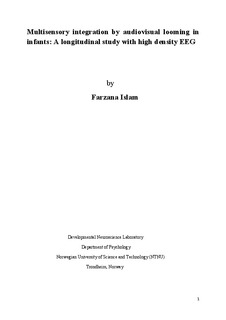| dc.description.abstract | Infants’ cortical electrical activity as a function of audiovisual looming perception was investigated using high-density electroencephalogram (EEG). Prospective control when responding to a looming object approaching on a direct collision course was studied longitudinally in infants aged 3/4 and 9/10 months. Different characteristics of peak VEP and AEP activity from infants’ brain electrical recordings were explored and compared between the infants at these different ages. The aim of this study was to find evidence for infant brain electrical responses to an audiovisual looming stimulus approaching the infant under three different accelerations. The results showed that there were differences in peak VEP and AEP activations with age. At the age of 3/4 months, infants showed peak VEP and AEP activation earlier in the looming sequence compared to when they were 9/10 months of age. AEP peaks occurred before VEP peaks in the looming sequence at both ages. Further, it was found that peak VEP activation in the investigated Oz and Pz areas propagated from the O area to the P area, indicating that the highest activation was observed in the O area at the age of 3/4 months, whereas the P area showed the highest activation when the infants were9/10 months old. Furthermore, amplitude activity occurring in the channels Cz and C3 showed differences in amplitude activity referring to an increased auditory area when infants were 9/10 months of age. The results suggest an evolved capacity to integrate multisensory looming objects. The decrease in processing time together with a peak VEP and AEP activation closer to the loom’s time-to-collision indicate a developmental trend in infants’ prediction of an object’s time-tocollision. Moreover, AEP occurring before VEP in the looming sequence suggested an enhancement in audiovisual looming perception. Amplitude activity at different channel shed light on audiovisual cortical pathways and indicated cortical pathways involved in multisensory looming perception. | nb_NO |
